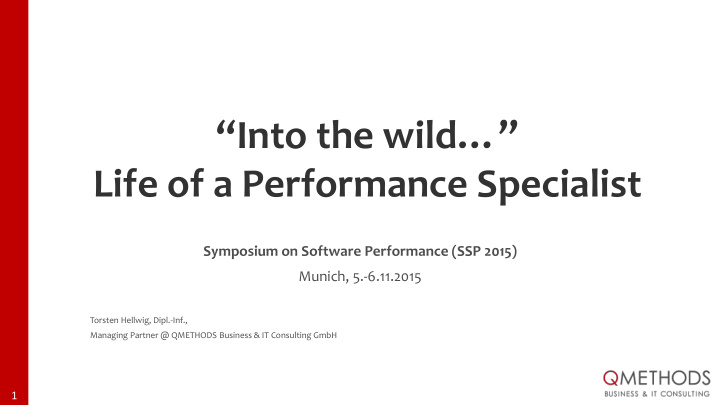



“Into the wild…” Life of a Performance Specialist Symposium on Software Performance (SSP 2015) Munich, 5.-6.11.2015 Torsten Hellwig, Dipl.-Inf., Managing Partner @ QMETHODS Business & IT Consulting GmbH 1
You don‘t need to walk to Alaska… 2
Who am I – how did it start first programming in 1986 Master in computer science from TU Dresden in 1998 software engineer and architect , Java, PHP, JS, … in 2003 established testing / QA at an insurance company „ moved to the other side “: leading Ops team – no system monitoring! 2010 first encounter with Applicaton Performance Management: Dynatrace Performance Consultant ever since … 3
What does an application performance guy do ? Troubleshoot application performance, yay ! Educating and evangelising APM Understand customers maturity, organisational structure, processes map requirements and expectations to a solution help with tooling decisions: demonstrate tools, prove value set up and establish tooling – develop customers maturity 4
A little theory on APM it‘s a lifecycle thing ! get grip and control over your environment performance requirements (NFRs to FRs) develop performance aware or – driven white-box testing holistic monitoring automation ! 5
What you need to look at… organisational classic siloed IT organization DevOps outsurcing skill levels maturity driving blind – end user experience, monitoring reactive, problem-driven aware and effective optimized process, continuous improvement technical environment tooling 6
Collaboration 7
Troubleshooting pro-actively new application to be rolled out – does it perform ? QA or users constantly complain Dev has no idea anymore Ops has no idea but ‚ more hardware !‘ Business needs a solution war room – the house is on fire outtages KPIs bad (conversion rate, revenue) project deadline was … yesterday 8
Example 1: Troubleshooting larger customer wants to introduce a new HR software big bang rollout planned and communicated to >1000 employees large peak in load expected on go-live vendor and hosting provider did some improvised load tests with jMeter more hosted hardware would drive up costs, still no guarantee 9
Approach first: wire up APM to the test environment which is used by manual testers – do End-to-End analysis over a whole day understand the app and user behaviour see the infrastructure check functional health second: repeat a properly defined load test under APM diagnosis proper definition: user behaviour patterns from above + capabilities of the load driver estimated virtual users: 1 VU = 25 real users system was able to sustain 300 real users … 10
Read the signs … 11
Example 2: business-driven, strategic-thinking „ We have no problems, we just want to stay ahead of the rest …“ strong growth – want to limit growing costs high peak to normal traffic ratio – elastic cloud business stakeholders want insight better collaboration wanted – software vendor and hosting provider are external application performance management is the key „ looks like a walk in the park …“ 12
What‘s the deal then ? understand their real situation full outsourcing ? uhm … a Bank, with demanding stakeholders really high traffic propose a solution and get it up and running integration+automation hotline incident management big data analytics collaboration process with both external parties skill transfer 13
Example 3: Out there in the wild… The Mainframe 14
Active APM user … it‘s about coverage you can‘t start everything at the same time complexity of project cost limited resources customer with classic IT organization does APM in Dev, Test and Ops started in the online business branch technology coverage left out the backend: Mainframe separate tooling – common architecture again – growth (mobile frontend) cost limiting: Mainframe pays per CPU usage ! 15
The task … Assess requirements propose a solution – extend APM into the Mainframe win the Mainframers evaluate tooling How ? get it up and running and FIND SOME PROOF the trick: correlation of distributed and mainframe on transaction level 16
Thanks for your patience! Questions ? Torsten Hellwig | Management Partner QMETHODS - Business & IT Consulting GmbH +49 (178) 838 0450 Stargarder Straße 10 10437 Berlin torsten.hellwig@qmethods.com Telefon : +49 (30) 22 19 86 51 Telefax : +49 (30) 22 19 86 53 E-Mail : info@qmethods.com Internet : http://www.qmethods.com
Recommend
More recommend